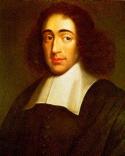
Back to alternative history
Contents
1. Preface
2. Spinoza's World, 1664
3. The Sabbateans
4. The Disputation
5. The Holy Land
6. Marriage
7. Common Prayer
8. America
9. Gottfried and Sophia
10. The Sublime Porte
11. Spinoza's World, 1691
12. Mustafa and the Janissaries
13. Naomi
14. Regime Change
15. Tulips
16. Twilight
17. Spinoza's World, 1712
18. Epilogue
Appendix
|
| Part 1: Preface |
|---|
|
This is the preface to a timeline in which the Jewish philosopher
Baruch Spinoza, after being excommunicated in Amsterdam, founds
an Enlightenment-based Jewish sect in Constantinople.
In OTL, Spinoza (1632-1677) was one of the first philosophers to
marry Jewish thought with the emerging ideas of the
Enlightenment, presaging the works of the Haskalah movement more
than a century later. Not since Maimonides, and possibly not
since Philo Judaeus in first-century Alexandria, had any Jewish
philosopher been so receptive to contemporary Western thought.
Spinoza has been called the first Jewish pantheist, and his deism
and rationalism - not to mention his rejection of theological
hierarchy and championship of intellectual freedom - were
revolutionary for the time.
In 1656, these ideas landed him in trouble before the rabbinic
authorities of Amsterdam, who declared him _herem_, a decree
equivalent to excommunication. Subsequently, he made a living as
a lens grinder and primary teacher while writing philosophical
treatises. Only one of these - a criticism of Descartes - was
published in his own name during his lifetime, although some of
his other works were published anonymously and he corresponded
with other contemporary philosophers. In 1677, at the age of 45,
he died of a lung disease contracted as a result of breathing
dust while grinding lenses.
|
|
|
The POD for this timeline is 1660. In that year, the Amsterdam
synagogue petitioned the municipal government to declare Spinoza
a "menace to all piety and morals." In OTL, he left Amsterdam
for good shortly thereafter, but continued to reside in the
Netherlands. In the ATL, the rabbinic authorities are more
successful, and succeed in having Spinoza exiled from Holland.
His destination is a place where Jews are emancipated and where a
rich Jewish intellectual life exists: the Ottoman Empire.
During the mid-17th century, the Jews of the Ottoman realm were
concentrated in four cities: Salonika/Thessaloniki,
Constantinople/ Istanbul, Smyrna/Izmir and Safed. Of the four,
Salonika had the largest Jewish community, with some 80,000 Jews
forming a majority of the city's population. Salonika, however,
tended to be a theologically conservative city, possibly for the
very reason that its Jewish community was largely self-
sufficient. Its thirty synagogues were organized in a loose
alliance governed by an elected board, and the rulings of this
board were binding on all Jews of the city. Such a hierarchy
would have little room for a maverick like Spinoza.
Neither would Smyrna. Not only was Smyrna also a provincial and
conservative city, but it had recently been home to another
famous Jewish troublemaker, the false messiah Sabbatai Zevi. At
the time of the POD, Zevi had been expelled from Smyrna for
heresy less than a decade earlier. The last thing the religious
authorities of Smyrna would want is another heretic in their
midst, especially one whose reputation precedes him.
Safed has
its attractions. In 1660, the Jewish community of Safed was
relatively new and was in a state of intellectual ferment; among
other things, Safed was the site of the first Gutenberg-type
printing press in Asia. The trouble, at least from Spinoza's
point of view, is that the prevailing currents of thought in
Safed were mystical, and stood in direct opposition to his
rationalism.
That leaves Constantinople, whose 20,000 Jews were the most
worldly and influential in the Ottoman Empire. It is here, among
the court physicians and civil servants of the Ottoman capital,
that Spinoza finds fertile ground for his progressive
philosophies. Although the rabbis of Constantinople complain,
Spinoza develops a following among the wealthier and more
assimilated Jewish families.
|
|
|
By 1664, Spinoza has published his Ethics and the Treatise on God,
Man and His Well-Being, both of which are derived from ideas he
conceived prior to the POD. Unlike OTL, he not only
publishes these books in his own name but does so as a man of God
rather than a secular philosopher. His congregation, by now numbering
thousands, recognizes him as its spiritual leader, and Jews from other
Turkish cities begin to come to his synagogue to study. The
established rabbinic authorities excommunicate him once again, and his
followers with him, but by then the movement has taken on a life of
its own. The idea of liberal Judaism, in which Jewish scripture is
married to contemporary philosophy and in which emancipated Jews take
full part in the life of their country, has begun.
|
|
|

